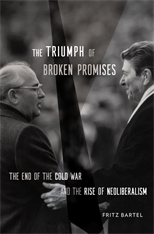Western money and Eastern promises

Fritz Bartel (2022) The Triumph of Broken Promises: The End of the Cold War and the Rise of Neoliberalism. Harvard University Press.
The turning point in the economic fortunes of the First and Second Worlds happened in the years 1973-75 when oil prices increased by six times (in real terms), economic growth decelerated, and the social contract between the governments and citizens based on ever increasing real incomes and cradle-to-grave social protection, broke down. This is not an original statement: dozens if not hundreds of books have been written with this thesis. What distinguishes Fritz Bartel’s impressively well-researched “The Triumph of Broken Promises” is his parallel analysis of how the crisis was handled in the democratic West and the authoritarian East, and how it ultimately led to the end of the Cold War and the fall of communism. It is this unified framework, plus its implications for several eminently political events: the break up of the Soviet Union and other Communist federations, the unification of Germany etc. that represents, in in my opinion, the book’s greatest strength.
The book can be summarized as follows. Faced with unprecedented economic shocks that made the continuation of post World War II policies impossible, both types of government had to resort to discipling of labor and “breaking of promises” with the citizenry. Western government were able to weather the storm because they had the support of capitalist money and enjoyed domestic legitimacy obtained through elections. Eastern government that heavily borrowed in order not to have to break promises, couldn’t repay the loans in the 1980s and found themselves at the mercy of world capitalism, and by extension of capitalist governments that controlled the international financial system.
 Now, why were communist governments so keen not to break promises, while Thatcher and Reagan did break them? And survived. The answer is politics. Governments in communist countries knew that their legitimacy could be maintained only so long as they provided numerous social services and did not insist too much on hard work. But that equation “we pretend to work and they pretend to pay us” could not continue forever. The economies sputtered, the rate of growth declined, social services deteriorated. The only answer was disciplining labor. In the West, that medicine was applied by Margaret Thatcher as she repressed organized labor and in particular the miners’ union (Scargill, any memories?); in the East by Edward Gierek and his numerous successors in Poland. Margaret Thatcher won because she had the support of other segments of society and labor found itself isolated. Communist governments could not exact concessions from labor since society at large did not see the governments as legitimate.
Now, why were communist governments so keen not to break promises, while Thatcher and Reagan did break them? And survived. The answer is politics. Governments in communist countries knew that their legitimacy could be maintained only so long as they provided numerous social services and did not insist too much on hard work. But that equation “we pretend to work and they pretend to pay us” could not continue forever. The economies sputtered, the rate of growth declined, social services deteriorated. The only answer was disciplining labor. In the West, that medicine was applied by Margaret Thatcher as she repressed organized labor and in particular the miners’ union (Scargill, any memories?); in the East by Edward Gierek and his numerous successors in Poland. Margaret Thatcher won because she had the support of other segments of society and labor found itself isolated. Communist governments could not exact concessions from labor since society at large did not see the governments as legitimate.
Poland and the UK provide almost template cases of the two systems and Bartel follows them closely. They are a natural experiment where many variables are the same, but one, crucial (political legitimacy) is different. It did not escape the attention of Mieczyslaw Rakowski, the last (and ultra reformist) Prime Minister of communist Poland that under Tadeusz Mazowiecki, the first non-communist Prime Minister, workers accepted without demurring such significant cuts in real wages and the standard of living that could not be imagined by any communist government. In fact, the reforms tried by the Vice Premier Sadowski in Poland in 1987, and those of Leszek Balcerowicz in 1989-90 were almost identical in their macroeconomic aspects: drastic cut in subsidies, mopping up of the so-called “liquidity overhand”, increased unemployment, liberalization of the exchange rate. But the Sadowski reforms floundered at the first step; the Balcerowicz reforms survived the difficult period, and established the basis for Poland’s future growth. It was indeed, in a famous phrase attributed to Balcerowicz, the short window of “extraordinary politics” that made it possible.
There is one aspect however that Bartel overlooks in his search for parallelism between the West and the East. Communist government were theoretically workers’ governments. This was their most important, and often sole, claim to legitimacy. Western governments were/are, despite all democratic sugarcoating, governments dedicated to the preservation of private property, and hence de facto capitalist governments. It was ideologically very difficult for communist governments to go against labor. The fact that Poland’s government had to fight its own workers showed its ideological bankruptcy. But for Western governments to go against labor was ideologically acceptable, even when it was politically difficult in countries where trade unions and socialist and communist parties were strong (France, Italy).
On the other end of the world, Paul Volcker’s “disciplining” caused a deep recession in the United States and hurt labor. But by increasing confidence of capital owners that the US would be willing, and able, to take a strong stance against labor and in favor of capital, they brought back confidence of the financial markets and stimulated large international capital inflows into the United States (“Volcker’s willingness to impose unprecedented economic discipline on the American people showed global capital holders that American policy makers could, and would, ultimately protect the interests of capital over the interests of labor”, p. 340). Those money inflows allowed the US to run forty years of uninterrupted current account deficits —a thing no other country in the world can dream of.
The structural difficulties, described in the case of Poland above, were magnified for the USSR. Because the USSR not only had to deal with similar internal economic problems as other East European countries, but also bore the burden of an inefficient empire. In several fast-pacing chapters Bartel describes the dilemma of Gorbachev and the Soviet leadership. They realized that there was a trade-off between domestic economics on the one hand, and military spending and subsidization of the Empire on the other (“We are at the limit of our capabilities”, told Gorbachev the Politburo in 1986, p. 178). Gradually, they reconciled themselves to the loss of the Empire provided they could “sell it” for hard currency with which to shore up domestic economy. But Gorbachev, Bartel argues, never really bit the bullet by reforming the economy. He talked and talked, promising that if money were forthcoming, he would use it to deepen and accelerate the perestroika. But even when the money came (as in the case of West Germany giving to the USSR aid and loans to the tune of 15 billion DMs), the reforms were not undertaken, and the fate of money is unclear.
(The end of Chapter 10 which tells the story of this unseemly bargain is riveting. It is a grand bazaar. Gorbachev begins by asking DM 20 billion in order to remove Soviet troops from East Germany. Kohl comes with only DM 5 billion. He asks Americans to help: they refuse. Kohl then scrambles to find a total of DM 8 billion, the offer that Gorbachev rejects as a “dead end”. Kohl moves to DM 12 billion. Still no good. In desperation, Kohl offers an additional DM 3 billion of interest-free loans. Deal.)
The last chapters leave us with tantalizing questions, particularly today. Why was Gorbachev so inept, both in negotiations and policy-making? Why was there such a disconnect between what Gorbachev rightly saw he needed to do and what he did? If the empire was to be sold, why was bargaining so badly done? Was it the lack of knowledge and sophistication from the leaders, shortage of time, inability to grasp consequences? It is unclear, but Bartel’s book, particularly in the chapters on the Soviet Union, will prompt many readers to ask these questions. When comparing Gorbachev endless chatter followed by begging for money with the exceedingly rational, cool, and measured Kohl (as well as George Bush senior) one is struck by the difference in the quality of statecraft. But surely individual differences cannot be a full answer for what happened. Gorbachev worked under the conditions where (perhaps because of the policies he adopted too) the ground was constantly shrinking: his room for maneuver was getting tinier and tinier by the day. Kohl, on the other hand, buoyed by the inflow of East German citizens, quasi bankruptcy of GDR, and “deep pockets” (to quote James Baker) of the Federal Republic, had a permanently expanding space for negotiation.
The book ends with a pertinent reflection on the two empires: the American Empire was/is a net gain to the United States, as the US managed to have members of the Empire fund its deficits and increased military spending. For the USSR, on the other hand, the empire was a net cost: it had to subsidize it, keep its military ever poised to intervene, and trade it off for domestic prosperity. (“After 1980, the American empire became an enormous material asset to Washington, while the Soviet empire remained an enormous burden for Moscow.”, p. 341). One empire was/is composed mostly of voluntary adherence, the other was composed of countries that were roped in. But the real difference was that one was economically successful and the other was not.
This first appeared on Branko's blog.
Photo by cottonbro studio


